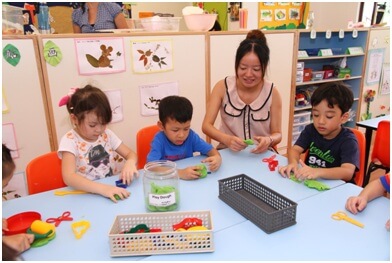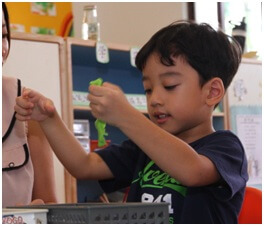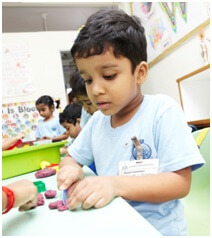Let's Have Fun with Dough!


Roll, poke, coil, pound, flatten, squeeze, stretch — there is nothing more hands-on than working with play dough! The physical pleasure of handling play dough is complimented by how open-ended it can be. Anything can be made from dough — a wiggly snake, a flat round pancake, a smiley cat, a barking dog. Yet, with a little quick squeeze, it becomes a lump of dough again ready to be moulded into another creation according to your child’s vivid imagination. The freedom to change one’s mind and create anew is one of the great joys of playing with dough.

Playing with dough or other modelling compounds enhances your child’s growth in every area. Experimenting with his hands develops and refines his finger and arm muscles, while improving his hand-eye coordination. Using a rolling pin and kneading lumps of clay promotes large-muscle development.
Socially, playing with dough encourages cooperation among children, as they share ideas and come together to work on projects. It’s also a great way for younger children to model as they can watch and learn from their older, faster companions who are more expressive and dextrous.
Emotionally, play dough offers a natural outlet for your child to express strong feelings. He can pound on a lump of dough if he’s angry or frustrated, or use a rolling pin to relax and release tension. The open-ended nature of play also offers your child a sense of success and achievement, increasing confidence and building self-esteem.


Cognitively and linguistically, playing with dough can foster a better grasp of math and science concepts. Dividing the dough requires your child you use one-to-one correspondent reasoning, and sharpens problem-solving skills. As you talk him through the process, he also expands his vocabulary and learns to associate the tactile sensations in his hands to words you use to describe them.
Make the dough
- 5 cups of flour
- 2 ½ cups of water
- 2 ½ cups of salt
- Food colouring
Mix the ingredients together thoroughly and use the food colouring to dye different portions of dough.
Activity #1: Different textures
Use unusual ingredients to add texture to play dough – this boosts both gross and fine motor skills as your child tries to incorporate different ingredients into the basic dough.
- Homemade play dough
- Large plastic bag
- Tactile items, such as cotton balls, pebbles, dried beans, dried coffee grounds, etc.
Note:
Any household materials with interesting textures can be used — green beans, red beans, white dried fungus cut into small bits, washing sponge cut into small bits, dried seeds from fruits such as papaya, jackfruit, avocado etc that have been washed or cleaned.
- Place each different tactile item into a separate bowl.
- Ask your child to touch each item one by one and describe them. Encourage him to use words such as soft, hard, smooth, rough, grainy, bumpy and slimy. Encourage children to pass the bowls around so they can feel all the materials.
- Working one bowl at a time, take a portion of dough and add some of the tactile item. Ask your child to knead the dough, and describe how the dough feels. Ask him to describe what he’s doing, and how the texture is changing.
Activity #2: Different smells
Instead of different textures, try expanding the activity to include different smells as well. Try using different food extracts (vanilla, pandan, lemon, almond), strong-smelling spices (anise, clove, peppercorns), essential oils or fragrant soaps.
Ask your child to describe the smell and help him to draw parallels to real-life experiences — try relating to a smell he is familiar with or has smelled before.
You may also like

From Cabin to Classroom: Journey of an Outstanding Early Childhood Educator
The PDP modules allowed me to get creative with lesson ideas and keep up with the ever-changing Early Childhood sector.

Ms Farhana Binte Mohamed Hassan
Early Years Educator - PCF Sparkletots @ Pioneer Block 987D (CC)

More Than Just a Place for Food
Young children are highly inquisitive, and learn most effectively with activities that allow exploration and experimentation.

Kinderland @ Yio Chu Kang

Little Fingers Create Great Art - A Community Project by Kinderland and Skool4kidz
I believe this collaborative effort is a very meaningful contribution to the SG50 celebrations.

Kinderland and Skool4Kidz